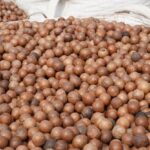Fusarium ear and stalk rot are common fungal diseases that affect maize (corn) plants. These diseases can cause significant yield losses if not properly managed. Here are some symptoms to look out for:
- Ear Rot:
- Discolored and shriveled kernels: Infected ears may have kernels that appear pink, white, gray, or brown. These kernels are often shrunken and may have a fluffy or cottony appearance.
- Mold growth: The infected kernels can be covered in a white, pink, or orange mold.
- Foul odor: Fusarium-infected ears may emit a musty or sour smell, especially when the husks are removed.
- Stalk Rot:
- Discolored and rotting stalks: Infected stalks may show discoloration, usually starting from the base and moving upward. The discoloration can vary in color, including brown, purple, or pink.
- Soft and spongy stalks: As the disease progresses, the infected stalks become soft and may feel spongy to the touch.
- Lodging: Severely infected plants can become weak and prone to lodging, where they fall over due to weakened stalks.
- Vascular discoloration:
- When you cut the stalk lengthwise, you may notice discoloration of the vascular tissues. The color can range from light brown to dark brown.
It’s important to note that the symptoms may vary depending on the maize hybrid, environmental conditions, and the specific Fusarium species involved. Some symptoms may resemble those caused by other diseases or conditions. If you suspect Fusarium ear or stalk rot, it is advisable to consult with an agricultural expert or plant pathologist for a proper diagnosis and management recommendations.









